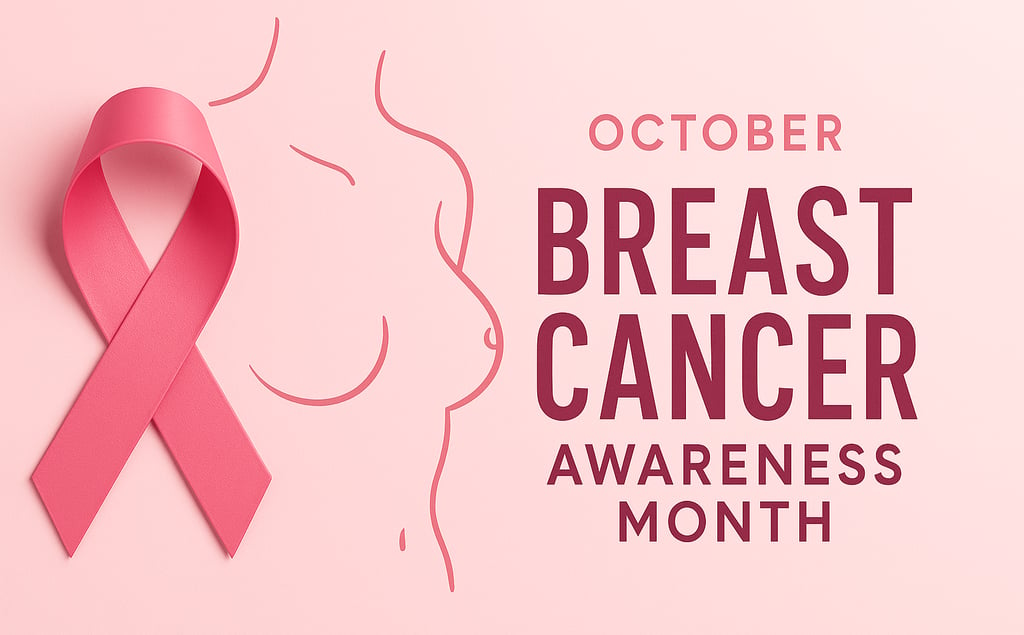Breast Cancer Awareness Month: Key Facts and Prevention Strategies
Breast cancer remains the most common cancer among women in the United States and globally. This article explores risk factors, genetic predispositions, screening recommendations, and advances in treatment during Breast Cancer Awareness Month, emphasizing the importance of early detection and prevention.


Understanding Breast Cancer
Breast cancer develops when glandular cells of the breast undergo malignant transformation, either in the milk ducts (ductal carcinoma) or in lobules that produce milk (lobular carcinoma). This transformation is driven by genetic mutations that accumulate over time, leading to uncontrolled cell growth and tumor formation.
Breast cancer can be localized (in situ) or invasive, spreading to nearby tissues, lymph nodes, and distant organs via the bloodstream, which can result in metastases.
Key Risk Factors
Age: Risk increases significantly after age 50.
Hormonal factors: Early menstruation, late menopause, few or no pregnancies, or a first pregnancy at a later age.
Lifestyle: Smoking, alcohol consumption, obesity, and diets high in saturated fats.
Genetics: Approximately 5–10% of breast cancers are hereditary, often linked to mutations in BRCA1 and BRCA2 genes. Women carrying these mutations face a significantly higher lifetime risk of breast and ovarian cancers.
Breast Cancer Awareness Month (BCAM)
Every October, BCAM raises awareness through education, screening initiatives, and fundraising for research. Supported by organizations such as the American Cancer Society and the Susan G. Komen Foundation, BCAM emphasizes the life-saving impact of early detection.
Screening recommendations (per CDC):
Breast self-awareness: Women should know how their breasts normally look and feel.
Clinical breast exams: Regular exams as advised by a healthcare provider.
Mammography: Every two years for women aged 50–74; earlier and more frequent for high-risk individuals.
Early detection dramatically improves survival rates, with a 90% five-year survival rate when caught early.
Treatment Options
Surgery: Lumpectomy or mastectomy depending on stage and spread.
Radiation therapy: Targets cancer cells locally while sparing healthy tissue.
Chemotherapy: Systemic treatment to control cancer cell spread.
Hormonal and targeted therapy: Blocks hormone receptors or specific molecular pathways driving cancer growth.
Prevention Strategies
Maintain a healthy weight.
Adopt an antioxidant-rich, plant-forward diet.
Limit alcohol and avoid smoking.
Stay physically active.
Participate in regular screening programs.
Why Awareness Matters
Breast cancer is the most frequently diagnosed cancer in women in the United States, with approximately 290,000 new cases and 43,000 deaths annually (American Cancer Society, 2023). Global campaigns like BCAM aim to save lives through education, early detection, and continuous research.
References
American Cancer Society (ACS). Breast Cancer Facts & Figures 2022–2023. https://www.cancer.org
Centers for Disease Control and Prevention (CDC). Breast Cancer Screening Guidelines. https://www.cdc.gov/cancer/breast/basic_info/screening.htm
National Cancer Institute (NCI). Genetics of Breast and Gynecologic Cancers (PDQ®). https://www.cancer.gov
World Health Organization (WHO). Breast cancer fact sheet. https://www.who.int
International Agency for Research on Cancer (IARC). Global Cancer Observatory: Cancer Today. https://gco.iarc.fr/today/home
